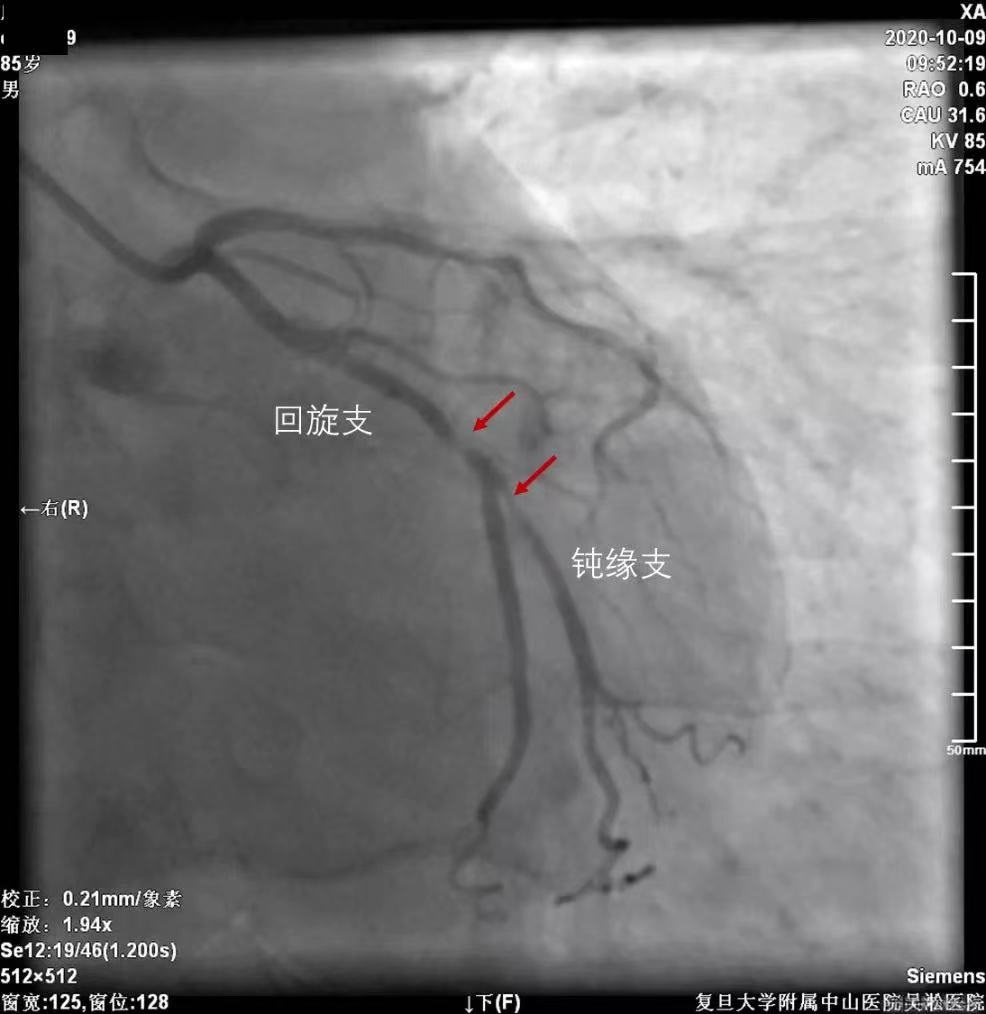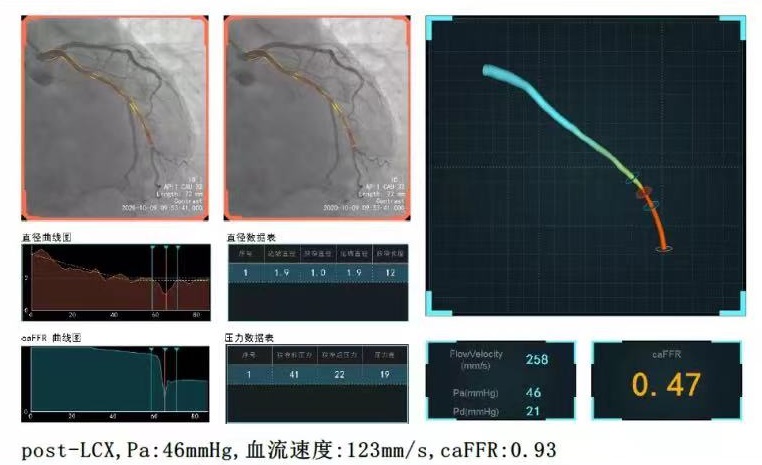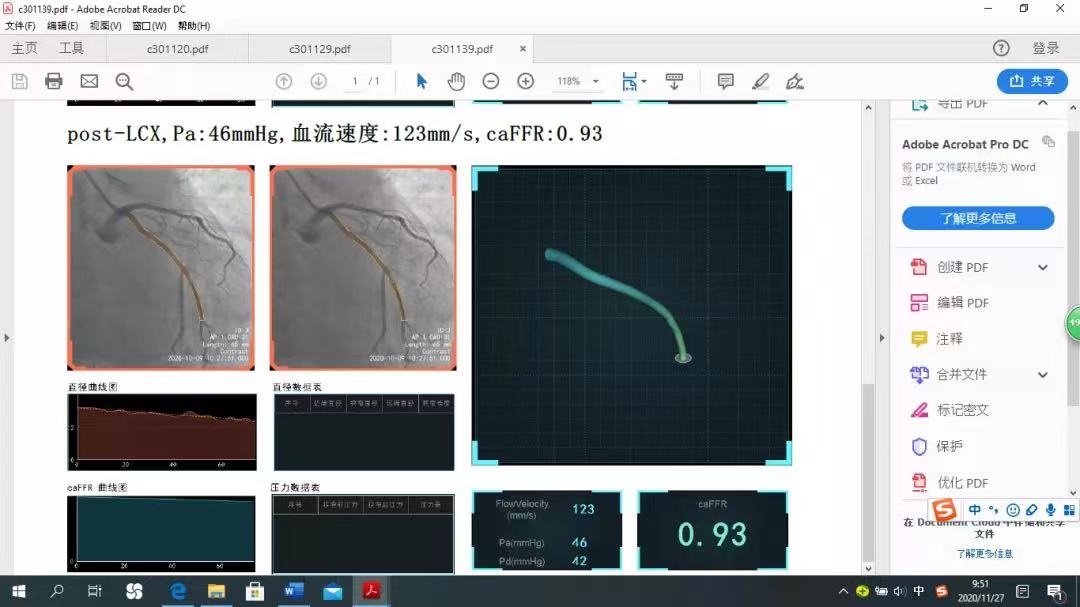caFFR provides accurate coronary artery functional assessment to guide the precise interventional treatment at Wusong Hospital of Zhongshan Hospital, Fudan University.
- Categories:Case Studies
- Author:
- Origin:
- Time of issue:2021-09-30 09:46
- Views:
(Summary description)Angiography-Derived FFR (caFFR) measurement technique was successfully developed in the Department of Cardiovascular Medicine, Wusong Hospital of Zhongshan Hospital, Fudan University. caFFR does not require invasive pressure guidewire, vasodilator and additional surgery and operations. Identical results were obtained with wire-derived FFR and caFFR.
caFFR provides accurate coronary artery functional assessment to guide the precise interventional treatment at Wusong Hospital of Zhongshan Hospital, Fudan University.
(Summary description)Angiography-Derived FFR (caFFR) measurement technique was successfully developed in the Department of Cardiovascular Medicine, Wusong Hospital of Zhongshan Hospital, Fudan University. caFFR does not require invasive pressure guidewire, vasodilator and additional surgery and operations. Identical results were obtained with wire-derived FFR and caFFR.
- Categories:Case Studies
- Author:
- Origin:
- Time of issue:2021-09-30 09:46
- Views:
Case source: Wusong Hospital of Zhongshan Hospital, Fudan University
Angiography-Derived FFR (caFFR) measurement technique was successfully developed in the Department of Cardiovascular Medicine, Wusong Hospital of Zhongshan Hospital, Fudan University. caFFR does not require invasive pressure guidewire, vasodilator and additional surgery and operations. Identical results were obtained with wire-derived FFR and caFFR.
Case profile:
● Patient Information: Mr. Tang, 85 years old, was admitted to the hospital due to "recurrent chest tightness for one year, aggravation for four hours"
● Past history: history of high blood pressure, hyperlipidemia, etc
Hospital examination:
● The ECG showed "sinus rhythm, complete right bundle branch block, left anterior branch block, ST-T change".
● Myocardial markers were not abnormally elevated. Considering the possibility of "coronary heart disease, unstable angina pectoris", they were admitted to the hospital for coronary angiography.
● Coronary angiography showed that 40% stenosis in the proximal and middle of left anterior descending coronary artery (LAD). The left circumflex coronary artery (LCX)was dominant, 60% stenosis before the mid-obtuse marginal branch (OM) bifurcation, and 70% stenosis in the opening and proximal OM.

Coronary angiography showed moderate stenosis in the mid-LCX and the proximal OM (the location indicated by the red arrow, 60-70% stenosis)
50-60% diffuse stenosis in the mid-RCA. In order to confirm the cause of chest pain, evaluate the relationship between chest pain and myocardial ischemia and identify the culprit lesion, the cardiology intervention team measured caFFR with the latest FlashAngio FFR System.

The results showed that the caFFR value in the mid-LCX and proximal OM was 0.47, which was significantly lower than the normal value of 0.8, suggesting that the lesion was related to the myocardial ischemia.
It also showed that the caFFR value of the LCX and OM lesion was 0.47, which was significantly lower than the normal value of 0.8, suggesting that the patient's chest pain was related to the myocardial ischemia caused by the lesion. One stent was placed into the lesion.

After stent placement, coronary angiography showed that the stenosis in LCX and OM was relieved (the blue arrow indicates the location of the stent).
The post-stenting caFFR recovered to 0.93.

The post-stenting caFFR recoverd to 0.93, which indicating that blood flow function was significantly improved after stent placement.
The patients recovered well after the operation and the symptoms of chest tightness were significantly improved.
The current study found that patients of 50-70% stenosis bases on standard angiography, 1/3 of them will be underestimated and missed the opportunities of revascularization to improve ischemia; and stenosis > 70% of patients with severe stenosis, there will be 20% of patients who were over treated.
Fractional flow reserve (FFR), the functional measurement of blood flow, can help physicians to better develop PCI strategies and verify surgical results. Due to the invasiveness of guide wire placement or the need for a hyperemic stimulus for interventional FFR and it is time-consuming, expensive and difficult to operate. Despite of guidelines for the use of interventional FFR, the global application is far from being ideal. “The Guidelines for Percutaneous Coronary Intervention in China” showed that the number of patients requiring FFR assessment in clinical practice accounts for about 46% of coronary angiography operations, but the utilization rate in the China is less than 1%. Therefore, there is an urgent need for a simple, accurate and efficient way to overcome these limitations. The newly introduced and recognized caFFR is non-invasive and does not require invasive pressure guidewire, vasodilator and additional surgery and operations. Identical results were obtained with wire-derived FFR and caFFR.
The study published in Cardiovascular Research showed that the diagnostic accuracy of caFFR reached 95.7%, with clear reliability.
Wusong Hospital of Zhongshan Hospital Fudan University actively introduces and widely carries out new caFFR for coronary functional assessment, accurately evaluates the relationship between coronary artery disease and myocardial ischemia, and then guides the formulation of reasonable treatment strategies, accurate treatment, and optimizes patient prognosis. It provides higher quality medical services for patients with cardiovascular diseases.
CONTACT US
0512-62622215
Address: Building 31, Northeast District, Nano City, No. 99 Jinji Lake Avenue, Suzhou industrial park
E-mail: market@rainmed.com

WeChat public account

Recruitment QR Code
Page Copyright© 2021- Suzhou Rainmed Medical Technology Co., Ltd. 苏公网安备32059002003601号 (苏)-非经营性-2021-0149


